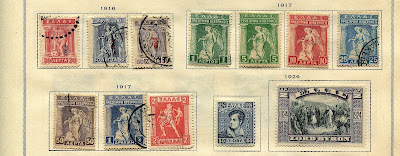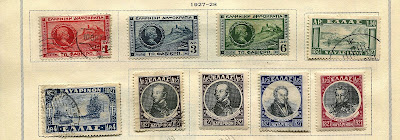1908 Scott 22 5c orange & black
"Scene on Brunei River"; Wmk 3
Into the Deep BlueBrunei in the 2017 Scott 1849-1940 Classic catalogue has 123 major descriptive numbers for the years 1895-1952. Of those, 34 are CV <$1-$1+, or 28%. Raising the bar to CV $10+, yields 84 stamps, or 68%. Brunei is moderately expensive for the WW collector. There are some specialty/ expensive areas for Brunei - including an 1895 local issue (ten stamps), 1942-44 Japanese Occupation stamps (nineteen stamps), and a 1944 red surcharged Japanese Occupation stamp with CV $7,000+. Since I don't have examples of these, I will say no more about them here.
For more on Brunei, see my....
Brunei Blog Post & BB Checklist
Brunei - Map from Stamp World History Site (Gerben)
Since Brunei is rather obscure to most WW collectors, I am also adding here a map from Stamp World History (site not presently active or available). This maps was put together by Gerben van Gelder. I received permission from him to display them (with proper acknowledgement), but I don't use that privilege very often - but will, in this case. It was an immense loss to WW philately when he passed away.
A closer look at the stamps and issues
100 Cents (Sen) = 1 Dollar
I should mention that there was a local issue produced in 1895 - "Star and Local Scene" - on ten stamps (I don't have an examples). CV is $4-$9+ for seven stamps. They were valid in Brunei and Labuan. For overseas, the mail was sent to Labuan, where Labuan stamps were used. During the early years, the local issue was considered "bogus" by philatelists, and had no Scott numbers. My 1947 Scott catalogue does not include these stamps. Evidence was uncovered in 1933 that, although "philatelic" in nature, they were in fact also a genuine local issue. Presently, they have Scott A1...A10 assigned.
In addition, in 1906, a twelve stamp overprinted'surcharged "Brunei" issue was produced, using 1902-03 Labuan stamps. (Again, I have no examples.) They are rather expensive, with a CV of $6 to $125.
1911 Scott 14 1c green
"Scene on Brunei River"; Wmk 3
Between 1907-1921, an engraved (by De la Rue) twenty-seven stamp set was issued with the iconic "Scene on the Brunei River" on Wmk 3 paper.
1911 1c green
Type II: Dots removed from bottom line of water shading (Single Plate)
Of interest, the 1c green is found in Type I (1908) and Type II (1911).
The Type I shows the lowest line of water shading as a string of horizontal dots. (These shading dots can be seen, for example, on the 2c brown & black shown below.)
The Type II (illustrated above) has the dots removed from the bottom line of water shading.
There is a similar finding for the 3c carmine - Type I (1908) & Type II (1916).
The Type I shows the lowest line of water shading as a string of horizontal dots. (These shading dots can be seen, for example, on the 2c brown & black shown below.)
The Type II (illustrated above) has the dots removed from the bottom line of water shading.
There is a similar finding for the 3c carmine - Type I (1908) & Type II (1916).
1911 Scott 16 2c brown & black
"Scene on Brunei River"; Wmk 3
Most of the stamps of this 1907-1921 De la Rue engraved issue are actually bi-colors.
Gorgeous!
CV ranges from <$1 to $10+ for eighteen stamps.
Gorgeous!
CV ranges from <$1 to $10+ for eighteen stamps.
1924 Scott 47 4c claret brown
"Scene on Brunei River"; Wmk 4
Between 1924-1937, "types" - in different colors - of the 1907 issue were produced on Wmk 4 paper. The issue consisted of sixteen stamps.
1933 Scott 51 5c brown
"Scene on Brunei River"; Wmk 4
CV for the 1924-37 issue ranges from <$1 to $10+ for fourteen stamps.
1931 Scott 60 6c red
"Dwellings in Town of Brunei"
In 1924 (6c black, 12c blue) and 1931 (6c red), three stamps were released with a scene of the dwellings in the town of Brunei.
Brunei Postcard circa 1960 showing stilt houses
Even in the 1960s one can see the prominence of stilt houses.
1947 Scott 63 2c gray
"Scene of Brunei River"; Wmk 4
Types of 1907-24
There was another "types" fourteen stamp engraved issue - again in different colors- released between 1947-1951.
1947 Scott 72 50c black
"Scene of Brunei River"; Wmk 4
Types of 1907-24
CV is <$1-$2+ for twelve stamps.
Major numbers are Perf 14, while Perf 14 1/2 V 13 1/2 & Perf 13 are minor numbers.
1949 Scott 78 50c blue & black
"Sultan Ahmed and Pile Dwellings"
Brunei was always a protectorate, and was governed by sultans, although the administration was British.
For the 25th anniversary of the reign of Sultan Ahmed Tajudin Akhazul Khair Wad-en, a three stamp issue set was released September 22, 1949.
For the 25th anniversary of the reign of Sultan Ahmed Tajudin Akhazul Khair Wad-en, a three stamp issue set was released September 22, 1949.
1952 Scott 84 2c red orange
"Sultan Omar Ali Saifuddin"
In 1952, eleven stamps were issued with the portrait of Sultan Omar Ali Saifuddin, who reigned between 1950-1967.
So ends a brief introduction of the stamps of Brunei. I would recommend getting the Stanley Gibbons Commonwealth & British Empire 1840-1970 catalogue if one is interested in exploring further the stamps of Brunei.
So ends a brief introduction of the stamps of Brunei. I would recommend getting the Stanley Gibbons Commonwealth & British Empire 1840-1970 catalogue if one is interested in exploring further the stamps of Brunei.
Deep Blue
1924-37 Wmk 4 Issue in Deep Blue
Deep Blue (Steiner) has nine pages for the 1906-1952 stamps of Brunei. Included are spaces for the minor number perforation varieties of 1950-51 for the "Scene on Brunei River" stamps.
On the other hand, My Steiner pages do not include the 1895 local issue, and the Japanese occupation WW II issues. I added quadrilled pages.
On the other hand, My Steiner pages do not include the 1895 local issue, and the Japanese occupation WW II issues. I added quadrilled pages.
1926 Scott 43 1c black
"Scene on Brunei River"; Wmk 4
Out of the Blue
This is another country where specialized concentration could yield interesting "exhibit" pages.
I have really only scratched the surface of Brunei studies.
I have really only scratched the surface of Brunei studies.
Note: Map is by permission of Gerben van Gelder (Stamps World History).
Scan pic of 1960 Town of Brunei appears to be in the public domain.
Scan pic of 1960 Town of Brunei appears to be in the public domain.
Links
Comments appreciated!






























































